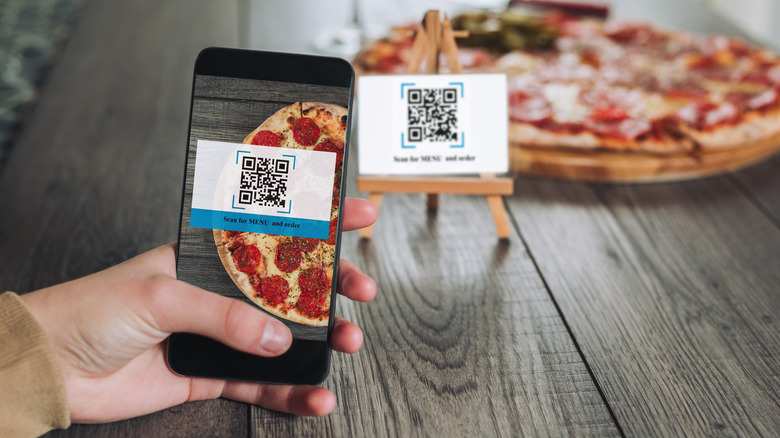How QR Codes Could Be Changing Restaurant Menus For The Worse
Among other notable moments, 2020 was the year of the QR code menu, and according to restaurant industry experts, they're not going away any time soon. CNBC reports that Bitly has seen a 750% increase in QR downloads over the last 18 months. Although they were originally invented in 1994 to keep track of car parts more easily, says the article, the codes have had a renaissance during the pandemic as a contactless way for customers to view restaurant menus. They have also allowed dining establishments to have a more flexible menu where they can, in real-time, remove out-of-stock items or adjust prices based on inflation.
According to Eater, some casual and fast-casual restaurants use QR codes from services like Scanour.menu to expedite the ordering process. With the service, diners can place their orders right from the online menu, which takes the pressure off of the already overwhelmed servers. Although QR codes have their benefits, many diners say they aren't fans and don't like pulling their phones out as soon as they sit down.
"I'm tired of having to navigate a new digital platform every time I eat out. I despise spending the first 10 minutes of a social engagement on my phone," said Christina Cauterucci, a senior writer for Slate. Cutting into organic socialization is one downfall of QR codes, but there are a few others that diners need to be aware of moving forward.
There's also privacy issues, price fluctuations, and changes to the service structure
While at the beginning of the pandemic, the major selling point of the QR code was the contactless menu, they also allow restaurants to collect information about diners through cookies (via Fox). This is beneficial for the restaurant because they can keep track of allergies and diner preferences (per Eater), but it also may come across as a breach of privacy. According to Fox, restaurants can use cookies to track customers' purchase history, name, phone number, and even credit cards.
The dynamic nature of a menu hosted on a QR code allows restaurants to communicate with the diners through the menu instead of through a server. According to Eater, the easily editable menus also allow restaurants to fluctuate prices throughout the day. If a certain dish is not selling well, customers could expect a price drop; or, if the cost of an ingredient inflates, they could see a price increase. Although this seems like a dramatic change, restaurants already practice this with happy hour specials and off-peak dinner specials.
At the end of the day, people visit a restaurant in order to be served, otherwise they would just order delivery. QR codes and increased automation of the dining experience take a bit of pressure off of the servers, but could result in a loss of personal connection for the diner. When diners are responsible for interpreting the menu, ordering, and paying, that takes away a bit of the hospitality and comfort associated with dining out.

